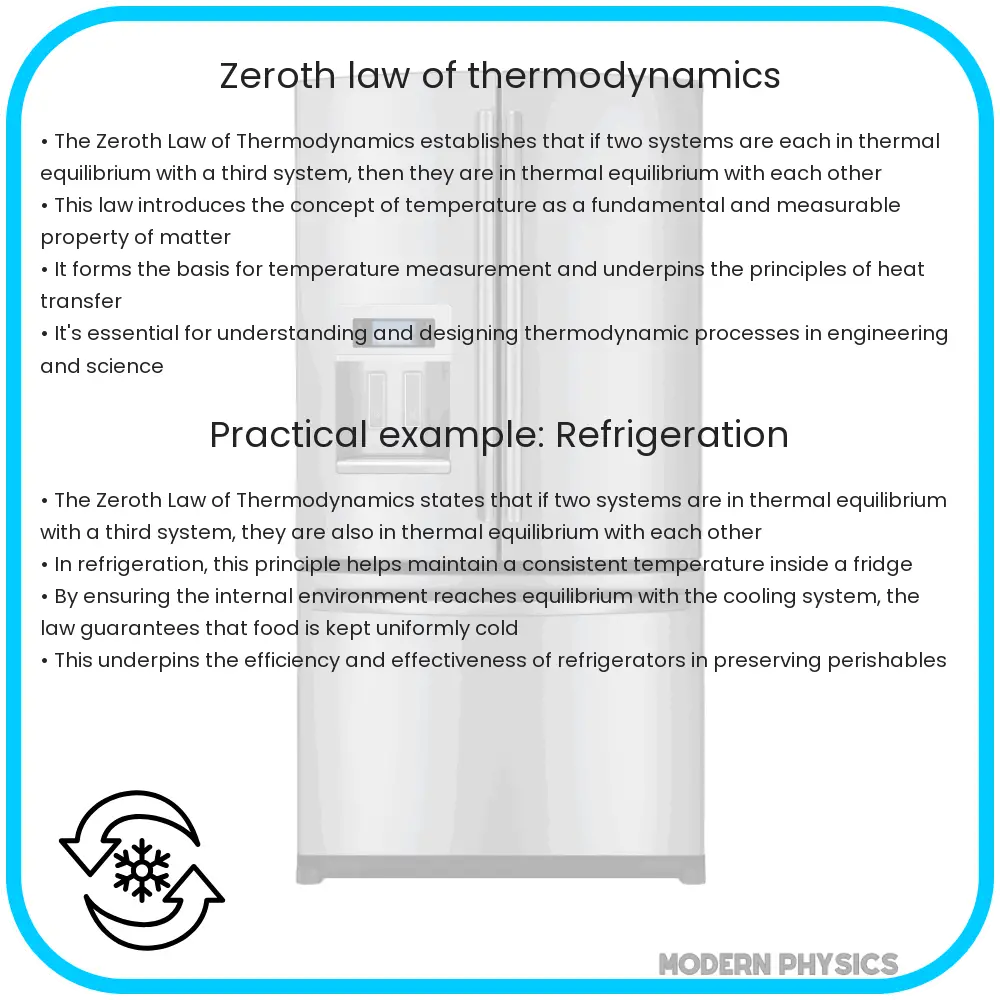Explore the Zeroth Law of Thermodynamics: its principles, implications for thermal equilibrium, temperature scales, and applications in science and engineering.

Understanding the Zeroth Law of Thermodynamics
The Zeroth Law of Thermodynamics is a fundamental principle that lays the groundwork for the study of thermal equilibrium and temperature in physics. Despite its late naming, it is considered the most basic and foundational among the laws of thermodynamics.
Foundations of the Zeroth Law
The Zeroth Law is primarily concerned with the concept of thermal equilibrium. It states that if two systems are each in thermal equilibrium with a third system, they are also in thermal equilibrium with each other. This principle forms the basis for the concept of temperature as a measurable physical property.
Thermal Equilibrium Principles
Thermal equilibrium is a key concept in thermodynamics, referring to a state where there are no net flows of thermal energy between multiple systems. This equilibrium is achieved when the systems involved reach the same temperature, ensuring that heat, which naturally flows from hotter to cooler systems, no longer transfers between them.
- Transitive Property: The Zeroth Law’s definition implies a transitive relationship in thermal equilibrium. If system A is in equilibrium with system C, and system B is also in equilibrium with system C, then A and B are in equilibrium with each other.
- Temperature Measurement: This law is fundamental in defining and measuring temperature. It implies that temperature is a property that can be used to determine if two bodies are in thermal equilibrium.
- Equilibrium and Energy Exchange: It’s important to note that thermal equilibrium does not mean that the systems stop exchanging energy. Rather, it indicates that the energy exchanged is balanced, resulting in no net energy flow.
Applications in Scientific and Engineering Fields
The Zeroth Law has significant implications in various fields. In scientific research, it is crucial for calibrating thermometers and understanding heat transfer. In engineering, it guides the design of thermal systems like heat exchangers and refrigeration units. By ensuring that systems can reach and maintain thermal equilibrium, engineers can design more efficient and effective thermal management solutions.
In conclusion, the Zeroth Law of Thermodynamics provides a fundamental understanding of thermal equilibrium and temperature. Its principles are essential in the fields of physics, engineering, and beyond, forming the basis for many applications that involve heat transfer and thermal management.
Expanding the Concept: Thermodynamic Equilibrium
The Zeroth Law not only introduces the concept of thermal equilibrium but also leads to a broader understanding of thermodynamic equilibrium. In thermodynamic equilibrium, a system is in balance not just thermally, but also mechanically and chemically. This means there are no unbalanced forces or chemical potential differences within the system or between the system and its surroundings. This comprehensive equilibrium state is crucial for analyzing complex systems in thermodynamics.
Role in the Thermodynamic Temperature Scale
One of the key applications of the Zeroth Law is in establishing the thermodynamic temperature scale. This scale, unlike the commonly used Celsius or Fahrenheit scales, is based purely on thermodynamic principles, independent of the properties of any specific material. The International Temperature Scale of 1990 (ITS-90), for instance, relies on the Zeroth Law for defining temperature points using fixed points and thermodynamic principles.
Implications in Statistical Mechanics
In statistical mechanics, the Zeroth Law helps in understanding the distribution of particles and energy in systems at thermal equilibrium. It provides a foundational perspective for the Boltzmann distribution and the concept of entropy, further bridging the gap between macroscopic thermodynamic properties and microscopic statistical behavior.
Challenges and Limitations
While the Zeroth Law is fundamental, it does have limitations, particularly in non-equilibrium thermodynamics. In systems far from equilibrium, such as rapidly changing states or systems with significant temperature gradients, the traditional concepts of thermal equilibrium and temperature become more complex and require advanced models and theories for accurate description.
Conclusion
The Zeroth Law of Thermodynamics, often overlooked due to its simplicity, plays a critical role in the understanding of thermal equilibrium and temperature. It serves as the cornerstone for temperature measurement, calibration of thermometers, and the basis for more advanced thermodynamic concepts. Its applications extend into various scientific and engineering disciplines, providing essential guidelines for designing and analyzing systems involving heat transfer. Despite its limitations in non-equilibrium scenarios, the Zeroth Law remains a fundamental concept that continues to shape our understanding of the thermal behavior of systems in the universe.
